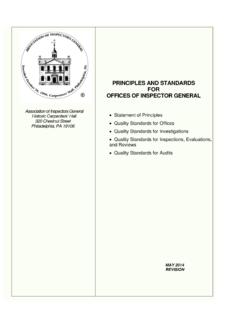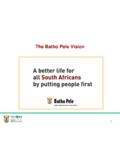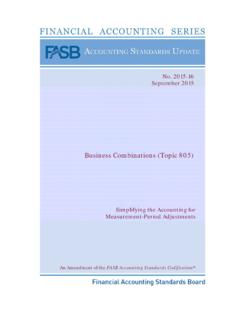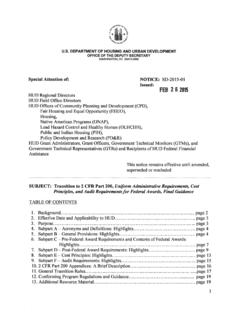Transcription of Inter-Agency Guiding Principles on …
1 inter -agencyGuiding Principles onUNACCOMPANIED andSEPARATED CHILDRENI nternational Committee of the Red CrossCentral Tracing agency and Protection Division19 Avenue de la Paix1202 Geneva, SwitzerlandT +41 22 734 60 01F +41 22 733 20 57E-mail: photo: Marie Chordi/ICRCJ anuary Guiding Principles ON unaccompanied AND separated Inter-Agency Guiding Principles on unaccompanied and separated children ,developed by this group for the purpose of Guiding future action, are based oninternational human rights, humanitarian and refugee law. They seek to ensurethat all actions and decisions taken concerning separated children are anchoredin a protection framework and respect the Principles of family unity and the bestinterests of the child. All stages of an emergency are addressed: from preventingseparations, to family tracing and reunification, through to interim care andlong-term solutions. The pooling of complementary skills and expertise that hasresulted in these Principles has to be matched by an equal level of collaborationon the ground if the rights and needs of separated children are to be effectivelyaddressed.
2 We jointly endorse these Principles and count on the support of allactors concerned with the welfare and protection of unaccompanied and separatedchildren to make them a reality at both policy-making and field Kellenberger, PresidentInternational Committee of the Red CrossGeorge Rupp, President and CEOI nternational Rescue CommitteeMike Aaronson, Director GeneralSave the children /UKCarol Bellamy, Executive DirectorUnited Nations children s FundRuud Lubbers, High CommissionerUnited Nations High Commissioner for RefugeesDean Hirsch, President/CEOW orld Vision InternationalForewordChildren separated from their parents and families because of conflict,population displacement or natural disasters are among the most from those closest to them, these children have lost the careand protection of their families in the turmoil, just when they most needthem. They face abuse and exploitation, and even their very survival may bethreatened. They may assume adult responsibilities, such as protecting andcaring for younger sisters and brothers.
3 children and adolescents who havelost all that is familiar home, family, friends, stability are potent symbols ofthe dramatic impact of humanitarian crises on individual lives. The breakdown of social structures and services accompanying major crisesmeans that communities and States themselves may not be in a position toprovide the necessary protection and care for children without families. It istherefore imperative that humanitarian organizations ensure that the mostvulnerable children are range and complexity of situations in which children become separatedfrom their families, and the diverse needs of the children themselves, meansthat no single organization can hope to solve the problem skills and mandates must be brought to bear in a concertedapproach to respond to this issue. Close Inter-Agency collaboration in the 1990 sled to the reunification of tens of thousands of Rwandan children with theirfamilies, in the aftermath of the crisis in the Great Lakes Region in Africa.
4 Thisis a heartening testimony to what can be achieved by working is against this backdrop that the Inter-Agency Working Group onUnaccompanied and separated children was set up in 1995. It brought togetherkey organizations with field experience of issues concerning separated objectives of the group are to promote and support preparedness,coordination and good practice based on lessons Guiding Principles ON unaccompanied AND separated Inter-Agency Guiding Principles on unaccompanied and separated children ,developed by this group for the purpose of Guiding future action, are based oninternational human rights, humanitarian and refugee law. They seek to ensurethat all actions and decisions taken concerning separated children are anchoredin a protection framework and respect the Principles of family unity and the bestinterests of the child. All stages of an emergency are addressed: from preventingseparations, to family tracing and reunification, through to interim care andlong-term solutions.
5 The pooling of complementary skills and expertise that hasresulted in these Principles has to be matched by an equal level of collaborationon the ground if the rights and needs of separated children are to be effectivelyaddressed. We jointly endorse these Principles and count on the support of allactors concerned with the welfare and protection of unaccompanied and separatedchildren to make them a reality at both policy-making and field Kellenberger, PresidentInternational Committee of the Red CrossGeorge Rupp, President and CEOI nternational Rescue CommitteeMike Aaronson, Director GeneralSave the children /UKCarol Bellamy, Executive DirectorUnited Nations children s FundRuud Lubbers, High CommissionerUnited Nations High Commissioner for RefugeesDean Hirsch, President/CEOW orld Vision InternationalForewordChildren separated from their parents and families because of conflict,population displacement or natural disasters are among the most from those closest to them, these children have lost the careand protection of their families in the turmoil, just when they most needthem.
6 They face abuse and exploitation, and even their very survival may bethreatened. They may assume adult responsibilities, such as protecting andcaring for younger sisters and brothers. children and adolescents who havelost all that is familiar home, family, friends, stability are potent symbols ofthe dramatic impact of humanitarian crises on individual lives. The breakdown of social structures and services accompanying major crisesmeans that communities and States themselves may not be in a position toprovide the necessary protection and care for children without families. It istherefore imperative that humanitarian organizations ensure that the mostvulnerable children are range and complexity of situations in which children become separatedfrom their families, and the diverse needs of the children themselves, meansthat no single organization can hope to solve the problem skills and mandates must be brought to bear in a concertedapproach to respond to this issue.
7 Close Inter-Agency collaboration in the 1990 sled to the reunification of tens of thousands of Rwandan children with theirfamilies, in the aftermath of the crisis in the Great Lakes Region in Africa. Thisis a heartening testimony to what can be achieved by working is against this backdrop that the Inter-Agency Working Group onUnaccompanied and separated children was set up in 1995. It brought togetherkey organizations with field experience of issues concerning separated objectives of the group are to promote and support preparedness,coordination and good practice based on lessons Guiding Principles ON unaccompanied AND separated Durable arrangements53a) Alternative long-term placement 54b) In-country and inter -country adoption 556. Special issues related to refugee children59a) Refugee status determination 60b) Rejected asylum-seekers 61c) children living in families from the host/asylum country 61d) Durable long-term solutions 627. Promoting children s rights 65a) Advocacy 66b) Capacity-building 67 Key international instruments relating to unaccompanied andseparated children 68 Selected reference material 70 Introduction 121.
8 A comprehensive approach 152. Preserving family unity 21a) Preventing separation 22b) Evacuation 24c) Legal identity and birth registration 273. Tracing and family reunification29a) Assessment 30b) Identification, registration and documentation 33c) Tracing 35d) Verification and family reunification 37e) Follow-up of placement and reunification 39f) Confidentiality 394. Care arrangements 41a) Emergency care and assistance 42b) Community-based care 43c) Fostering 44d) Institutional care 46e) Guardianship 47f) Health care and nutrition 48g) Education 49h) Psycho-social aspects 50i) Child-headed households Guiding Principles ON unaccompanied AND separated Durable arrangements53a) Alternative long-term placement 54b) In-country and inter -country adoption 556. Special issues related to refugee children59a) Refugee status determination 60b) Rejected asylum-seekers 61c) children living in families from the host/asylum country 61d) Durable long-term solutions 627.
9 Promoting children s rights 65a) Advocacy 66b) Capacity-building 67 Key international instruments relating to unaccompanied andseparated children 68 Selected reference material 70 Introduction 121. A comprehensive approach 152. Preserving family unity 21a) Preventing separation 22b) Evacuation 24c) Legal identity and birth registration 273. Tracing and family reunification29a) Assessment 30b) Identification, registration and documentation 33c) Tracing 35d) Verification and family reunification 37e) Follow-up of placement and reunification 39f) Confidentiality 394. Care arrangements 41a) Emergency care and assistance 42b) Community-based care 43c) Fostering 44d) Institutional care 46e) Guardianship 47f) Health care and nutrition 48g) Education 49h) Psycho-social aspects 50i) Child-headed households Guiding Principles ON unaccompanied AND separated Rescue Committee (IRC)122 East 42nd Street, 12th FloorNew York, NY 10168, USATel: (212) 551-3000 in 1933, the International Rescue Committee is theleading non-sectarian, voluntary organization serving refugeesand victims of oppression or violent conflict.
10 IRC is committed tofreedom, human dignity and self-reliance. The IRC is currently at workin some 30 , the IRC provides emergency water and sanitation, shelter,health services, emergency education, and psycho-social care andprotection for vulnerable children and youths, often operating in themidst of conflict. For those who are granted refugee status by the USgovernment, 15 regional offices provide access to housing, education,job placement, and other services to help them begin life in their IRC s children Affected by Armed Conflict Unit addresses theimmediate and longer term psycho-social needs of conflict-affectedchildren and adolescents. Its services include child and adolescentprotection; education; rehabilitation and reintegration of former childsoldiers; care, tracing and family reunification of separated children ;and programmes to aid child victims of sexual violence and on the organizations thatcontributed to the present publicationThe ICRC is an impartial, neutral and independent organization whoseexclusively humanitarian mission is to protect the lives and dignity ofvictims of war and internal violence and to relieve, and where possibleprevent, suffering caused by such situations.















